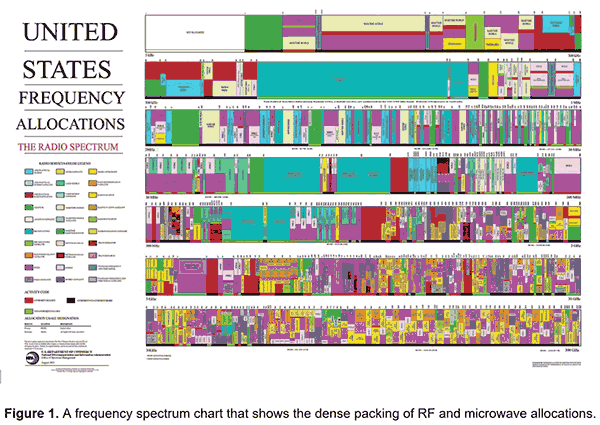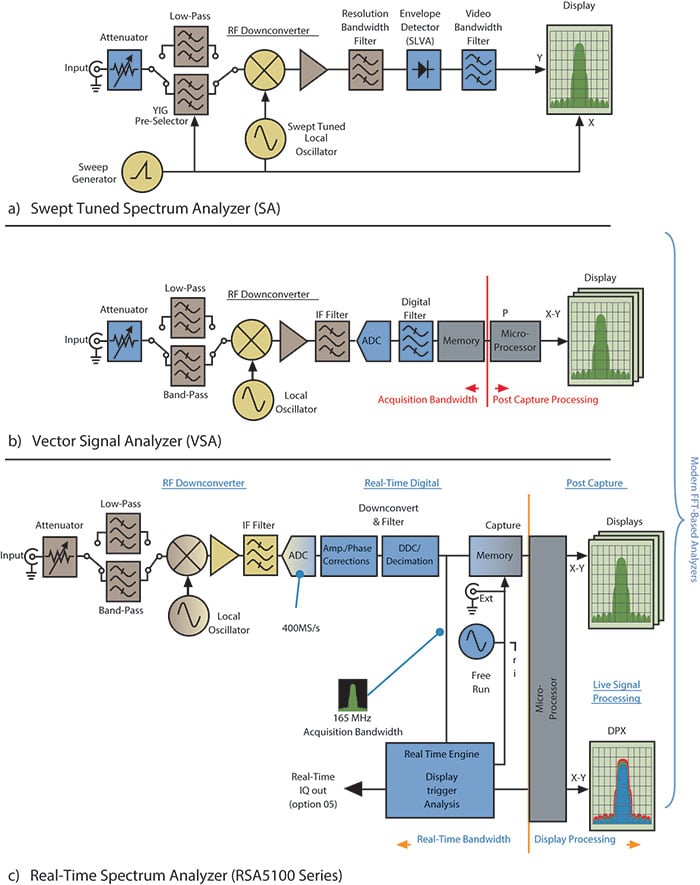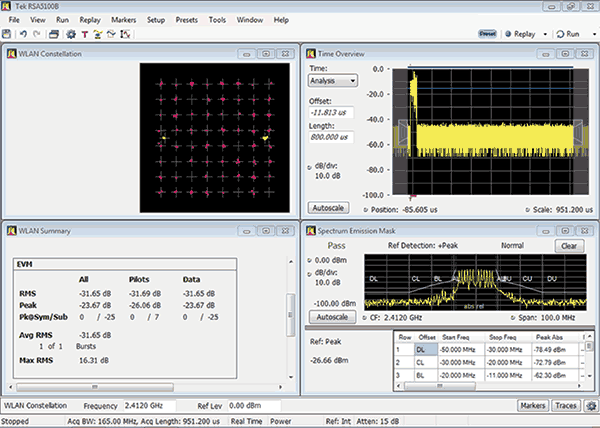
A spectrum analyzer measures the magnitude of an input signal versus frequency within the full frequency range of the instrument. The primary use is to measure the power of the spectrum of known and unknown signals. Given the challenge of characterizing the behavior of today’s RF devices, it is necessary to understand how frequency, amplitude, and modulation parameters behave over short and long intervals of time.
Traditional tools like Swept Spectrum Analyzers (SA) and Vector Signal Analyzers (VSA) provide snapshots of the signal in the frequency domain or the modulation domain. This is often not enough information to confidently describe the dynamic nature of modern RF signals. To overcome these evolving challenges, it is crucial for today’s engineers and scientists to be able to reliably detect and characterize RF signals that change over time, something not easily done with traditional measurement tools.
The Real-time Spectrum Analyzer (RSA) is an instrument that can discover elusive effects in RF signals, trigger on those effects, seamlessly capture them into memory, and analyze them in the frequency, time, modulation, statistical and code domains.
As RF signals have become ubiquitous in the modern world, so too have problems with interference between the devices that generate them. To overcome evolving challenges, it is crucial for today’s engineers and scientists to be able to reliably detect and characterize RF signals that change over time, something not easily done with traditional measurement tools.
One such measurement tool that’s evolved to keep up is the Real-Time Spectrum Analyzer. A real-time spectrum analyzer can help with most modern RF measurement challenges, like: discovery of rare, short deration events; seeing weak signals masked by stronger ones; observing signals masked by noise, finding and analyzing transient and dynamic signals; capturing burst transmissions, glitches, switching transients, to just name a few.

Main Types of Spectrum Analyzers
Spectrum Analyzers can be classified in 3 basic categories in reference to their architecture – Swept Spectrum Analyzers (SA) and Vector Signal Analyzers (VSA) and Real-time Spectrum Analyzers (RSA).
Swept Spectrum Analyzers (SA)
The swept-tuned, superheterodyne spectrum analyzer is the traditional architecture and is best suited for observing controlled, static signals. The SA makes power vs. frequency measurements by downconverting the signal of interest and sweeping it through the passband of a resolution bandwidth (RBW) filter. The RBW filter is followed by a detector that calculates the amplitude at each frequency point in the selected span. While this method can provide high dynamic range, its disadvantage is that it can only calculate the amplitude data for one frequency point at a time. Consequently, measurements are only valid for relatively stable, unchanging input signals Consequently, measurements are only valid for relatively stable, unchanging input signals
Vector Signal Analyzers (VSA)
Analyzing signals carrying digital modulation requires vector measurements that provide both magnitude and phase information. A VSA digitizes all the RF power within the passband of the instrument and puts the digitized waveform into memory. The waveform in memory contains both the magnitude and phase information which can be used by digital signal processing (DSP) for demodulation, measurements, or display processing. While the VSA has added the ability to store waveforms in memory, it is limited in its ability to analyze transient events. The serial nature of batch processing common in means that the instrument is effectively blind to events that occur between acquisitions. Single or infrequent events cannot be discovered reliably, so external triggering may be necessary and requires impractical prior knowledge of these transient events. Other limitations of the VSA include challenges in isolation of weak signals in the presence of larger ones and signals that change in frequency but not amplitude.
Real-time Spectrum Analyzers (RSA)
The RSA performs signal analysis using real-time digital signal processing (DSP) that is done prior to memory storage as opposed to the post-acquisition processing that is common in the VSA architecture. Real time processing allows the user to discover events that are invisible to other architectures and to trigger on those events allowing their selective capture into memory. The data in memory can then be extensively analyzed in multiple domains using batch processing. The real-time DSP engine is also used to perform signal conditioning, calibration and certain types of analysis.
What is the difference between a spectrum analyzer and an oscilloscope?
Oscilloscopes and spectrum analyzers are two of the most important instruments in any electronic laboratory. Simply speaking, a spectrum analyzer is used to measure frequency information on a signal, whereas oscilloscopes are used to measure the timing information around a signal. In real life, however, the nature of signals is not known in advance, so having both instruments allows proper characterization of the signal. It is important to note that spectrum analyzer scopes have both instruments in one to allow a more comprehensive measure of a signal or portability in certain environments. The much more sensitive capabilities or immediate measurements of an RSA are just some of the reasons one might choose a spectrum analyzer as a separate instrument.
What do spectrum analyzers measure?
Spectrum analyzers are used for many measurements including:
- Frequency Response, Noise and Distortion characteristics of all kinds of radio-frequency circuitry
- Occupied Bandwidth and Interference Sources in Telecommunications
- Basic Pre-Compliance Testing for EMC Testing
Other measurement techniques involve setting up the spectrum analyzer to test harmonics of audio signals by musicians and audio engineers, using reflective or refractive techniques to separate out the wavelengths of light with optical spectrum analyzers, and vibration amplitudes at various component frequencies among many others. The measurement techniques you will use will depend on your application, but hopefully these basics are enough to get started.
Why use a Spectrum Analyzer?
Given the challenge of characterizing the behavior of today’s RF devices, it is necessary to understand how frequency, amplitude, and modulation parameters behave over short and long intervals of time. Traditional tools like Swept Spectrum Analyzers (SA) and Vector Signal Analyzers (VSA) provide snapshots of the signal in the frequency domain or the modulation domain. This is often not enough information to confidently describe the dynamic nature of modern RF signals.
The Real-Time Spectrum Analyzer (RTSA) architecture is designed to overcome the measurement limitations of the SA and VSA to better address the challenges associated with transient and dynamic RF signals. The Real-Time Spectrum Analyzer performs signal analysis using real-time digital signal processing (DSP) that is done prior to memory storage. Real time processing allows the user to discover events that are invisible to other architectures and to trigger on those events allowing their selective capture into memory. The data in memory can then be extensively analyzed in multiple domains using batch processing.
How does a Spectrum Analyzer Work?
Modern RSAs can acquire a passband, or span, anywhere within the input frequency range of the analyzer. At the heart of this capability is an RF downconverter followed by a wideband intermediate frequency (IF) section. An ADC digitizes the IF signal and the system carries out all further steps digitally. DSP algorithms perform all signal conditioning and analysis functions.
For spectrum analysis to be classified as real-time, all information contained within the span of interest must be processed indefinitely without gaps. An RTSA must take all information contained in time domain waveform and transform it into frequency domain signals. To do this in real-time requires several important signal processing requirements:
- Enough capture bandwidth to support analysis of the signal of interest
- A high enough ADC clock rate to exceed the Nyquist criteria for the capture bandwidth
- A long enough analysis interval to support the narrowest resolution bandwidth (RBW) of interest
- A fast enough DFT transform rate to exceed the Nyquist criteria for the RBW of interest
- DFT rates exceeding the Nyquist criteria for RBW require overlapping DFT frames:
- The amount of overlap depends on the window function
- The window function is determined by the RBW

What applications can you use a Spectrum Analyzer for?
Whether you’re in the field or in the lab, a Real-Time Spectrum Analyzer can be used for multiple applications like: voice and data communications (like cellular radio or radio communications); video broadcast distributed via satellite using DVB-S and DVB-S2 formats, and digital video is broadcast using the DVB-T format; radar, like radar transmitter test analysis; and spectrum management and interference hunting.
One of the most popular applications is Wireless local area network (WLAN) testing, also known as Wi-fi testing.
How to use a Spectrum Analyzer for Wi-fi testing
Wireless local area networks have become ubiquitous in the last decade as computing has become pervasive in the office, the home, and in personal communications. From the original specifications for Wi-Fi as the IEEE 802.11 standard in the 2.4 GHz industrial, scientific, and medical (ISM) unlicensed frequency band, Wi-Fi has undergone more than a half dozen revisions and progressed from a 2 Mb/s channel to multiple channels with more than 1 Gb/s throughput. Frequency bands now include 2.4 GHz, 3.6 GHz, 5 GHz, and 60 GHz. Currently the most popular variants are 802.11g (2.4 GHz), 802.11n (2.4 and 5 GHz), and 802.11ac (5 GHz).
Testing WLAN transmission with the newer standards can present some challenges. There are optional implementations for channel bandwidth, modulation type, and the number of spatial streams. A spectrum analyzer should have a real-time bandwidth of 120 MHz for testing an 80 MHz WLAN channel to measure transmitter spectrum emission mask tests, unless there is some external trigger method that allows triggering outside the IF bandwidth.
A test instrument should also have good enough linearity and noise specifications to permit measuring the very low EVM that is required for implementation of 256QAM modulation; since the device EVM should be < -32 dBm for 256QAM 5/6 coding, a spectrum analyzer should be at least 10 dB better than that, or <-42 dBm in order to accurately measure the signal without contributing distortion. Finally, for testing of multiple spatial streams the test equipment should have up to 8 independent capture channels that are synchronized to permit phase accurate measurements from multiple antennas.
Tektronix real-time spectrum analyzers at the low end have a 40 MHz real-time bandwidth, which is adequate for characterization and decoding of 40 MHz WLAN channels. It is possible to synchronize these instruments, so multiple WLAN spatial channels can be captured and analyzed.
Wi-Fi transmitters can also be characterized by spectrum emission mask testing for wider channels than 40 MHz, since wide real-time bandwidth is not needed for this type of test, provided that some method of triggering on signal bursts is available, as discussed earlier. The higher-end Tektronix spectrum analyzers have a real-time bandwidth of 165 MHz, which is adequate for full characterization of 160 MHz WLAN channels. The RSA5100B has a residual EVM spec of -49 dBm, which is more than adequate for testing complex modulation such as 256QAM.

Learn more about Tektronix spectrum analyzers»

